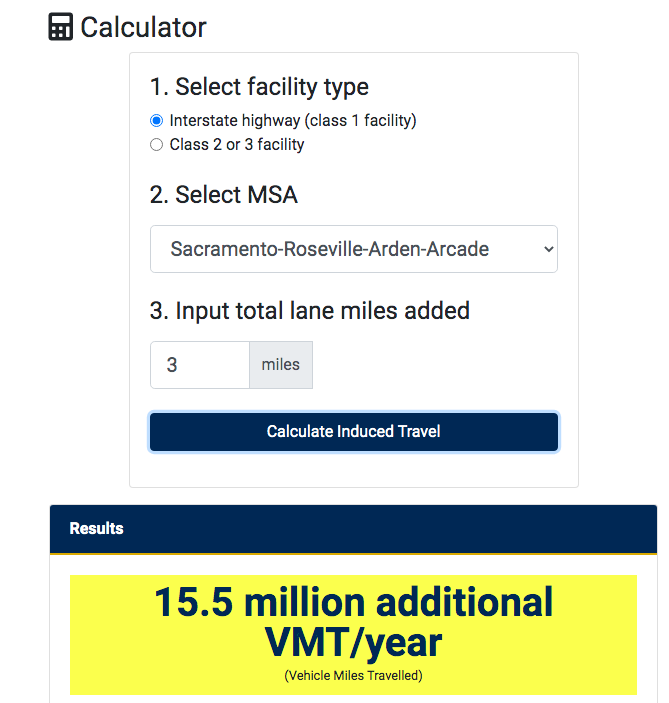Widening I-5 at the Rose Quarter in Portland will produce an addition 17.4 to 34.8 million miles of vehicle travel and 7.8 to 15.5 thousand tons of greenhouse gases per year.
These estimates come from a customized calibration of the induced travel calculator to the Portland Metropolitan Area.
It’s scientifically proven that increasing freeway capacity in dense urban environments stimulates additional car travel. The explanation is simple:
Attempts to address traffic congestion commonly rely on increasing roadway capacity, e.g. by building new roadways or adding lanes to existing facilities. But studies examining that approach indicate it is only a temporary fix. They consistently show that adding roadway capacity in congested areas actually increases network-wide vehicle miles traveled (VMT) by a nearly equivalent proportion within a few years, reducing or negating the initial congestion relief. That increase in VMT is called “induced travel.”
The phenomenon of induced demand is so well-demonstrated that its known as the “fundamental law” of road congestion. As the experience with Houston’s 23-lane Katy Freeway shows, no matter how many lanes you add to a freeway in a dense urban setting, added capacity simply prompts more driving
Transportation experts at the University of California Davis National Center for Sustainable Transportation have developed an induced travel calculator, based on the best available scientific information on the effect of added freeway capacity on vehicle travel. The developers of the calculator—Jamey Volker, Amy Lee and Susan Handy—have published a peer-reviewed article describing the empirical estimates in the literature showing the connection between capacity and VMT. In their journal article, the authors find that highway departments usually only address induced demand in response to public comments, rarely apply state-of-the-art modeling to their analysis, and routinely underestimate the effects of induced demand, by as much as an order of magnitude.
The purpose of this model is to provide an independent, scientifically sound means of measuring the environmental effects of major transportation projects.

In addition, because greenhouse gases are directly related to vehicle miles of travel—each thousand mile traveled by a typical automobile produces about .466 tons of greenhouse gases—the calculator also can be used to show the climate change impact of freeway expansion projects.
A Portland-calibrated version of the Induced Travel Calculator
After consulting with the authors of California calculator, we calibrated the calculator for use in the Portland metropolitan area. The key variables in the calculator include the number of interstate freeway lane miles in the urbanized portion of the metropolitan area, and the number of vehicle miles of travel on those roadways. The literature on induced demand shows that vehicle travel exhibits and unit elasticity with respect to roadway capacity: a one percent increase in road capacity tends to result in a one percent increase in vehicle miles traveled.
Using data from the US Department of Transportation (vehicles miles traveled) and from the Oregon and Washington departments of transportation (interstate freeway lane miles) inside urbanized areas, we created a Portland-metro specific version of the California calculator.
We computed the induced travel impact of two possible scenarios for the proposed I-5 Rose Quarter Freeway widening project using Portland-calibrated version of the calculator. Option one was expanding the current 1.5 mile stretch of freeway from 4 lanes to 6 (which is how the Oregon Department of Transportation describes the project, although they misleadingly call the added lanes “auxiliary” lanes. Option two is expanding the same stretch of freeway to eight lanes, which is what would easily fit in the 126 foot wide right of way that Oregon DOT proposes to construct.
The calculator suggests that the expansion to six lanes would add about 17.4 million vehicle miles per year to travel in the Portland metropolitan area, and that the expansion to eight lanes would add 34.8 million vehicle miles of travel.
These additional vehicle miles of travel have many negative effects. As “fundamental law” suggests, they’ll entirely offset congestion reduction benefits of freeway widening. In addition, there will be an increase in air pollution proportionate to the increase in vehicle travel. Additional VMT translates directly into increased greenhouse gas emissions, at nearly a half ton of greenhouse gases per thousand miles, this means that the widened freeway can be expected to increase greenhouse gas pollution in Portland by between 7.7 and 15.5 thousand tons per year.
The Volker/Lee/Handy model represents the latest, independent, state of the art method for estimating greenhouse gases associated with freeway expansion projects. This, and not the self-serving and incorrect estimates generated by the Oregon Department of Transportation should be used to define the environmental impacts of this project.
References
Jamey M. B. Volker, Amy E. Lee, Susan Handy, “Induced Vehicle Travel in the Environmental Review Process,” Transportation Research Record, Volume: 2674 issue: 7, (July, 2020) pages 468-479
The author wants to thank Doctor Volker for reviewing the methodology and data used in the Portland version of the calculator. Any errors are solely the responsibility of City Observatory.

